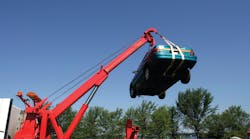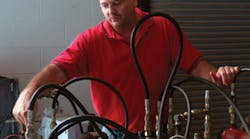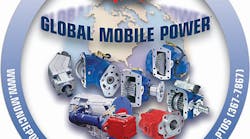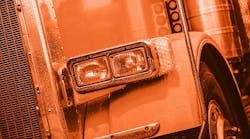When it comes to hydraulic systems, care taken during the specification process can pay dividends in terms of maintenance and component longevity. That's because when hydraulic system components are properly specified, the system operates at a higher level of efficiency, generates less damaging heat, and lasts longer.
The specification process should always begin with the work to be done. For example, a dump trailer, an ejector trailer and a live floor trailer may be similar in appearance, yet each requires very different hydraulic components. Choosing a pump and reservoir designed for a dump trailer application and fitting them on a live floor or ejector trailer application can have disastrous results.
When discussing hydraulic components with your supplier, always provide the make and model numbers of the equipment being powered, as well as the manufacturer's recommended operating flow and pressure requirements. Also be sure to tell the supplier if more than one type of trailer may be used with the same tractor, as this will require a specialized system designed around the differing requirements.
Key parameters include flow requirements, operating pounds per square inch (psi) and length of duty cycle.
HYDRAULIC PUMP
Also to be considered is how the hydraulic pump will be driven. Typically, this will be through a power take-off (PTO), but it could also be through a belt-driven pump or via a driveshaft directly from the engine crankshaft.
The hydraulic pump produces the flow to perform the work. The rate of flow determines the speed at which the equipment will operate. Therefore, it is important to follow the equipment manufacturer's recommendation.
An undersized pump may do the work, but slowly. An oversized pump may cause equipment to operate too fast, creating a potentially dangerous situation.
Also, oversizing the pump may result in higher system heat which, in turn, shortens the life of oil and components. In specifying a hydraulic pump, bigger is not better.
OPERATING PRESSURE
Operating pressure determines the force generated within the hydraulic system. This is another area where the equipment manufacturer's specifications must be adhered to.
The pump selected must be able to tolerate the operating pressure up to the relief valve setting. Twisted pump shafts and excessive gear housing cut-out are common symptoms of pump over-pressurization and can be prevented by specifying the right pump to start with and maintaining relief valve settings within the range specified by the manufacturer of the equipment.
If a pump is losing efficiency or the system is operating slowly, adjusting the relief valve will not make it work faster.
DUTY CYCLE
The duty cycle of the equipment must be considered when specifying reservoir size and reservoir type, and when determining whether or not a heat exchanger may be required. Longer duty cycles result in higher temperatures. In order to dissipate heat, reservoir capacity may need to be increased.
Some applications with short or intermittent duty cycles will require only enough reservoir capacity to extend the hydraulic cylinder while leaving four to six inches of reserve in the tank. Applications with longer duty cycles require larger reservoirs or heat exchangers.
The determining factor is oil temperature. As long as the operating temperature stays below 140 degrees F the reservoir is adequate.
Reservoir material plays a role here as well. Aluminum tanks are more effective at dissipating heat than steel or polyethylene. Polyethylene reservoirs are lightweight and are a good choice for a dump trailer but should not be used in long duty cycle applications like live floors.
HOSES
Hose size and routing are additional essential considerations. First and foremost, hoses must be adequately sized. Hose diameters should be based on system flow, not port size.
Undersized inlet hoses can cause cavitation damage in a pump. Undersized pressure hoses create restriction and increase neutral system pressure which adds to system heat. Undersized return hoses can create restriction and damage the directional valve.
All of these situations will drive up maintenance costs by shortening component life.
On the subject of hose, consider that the inside of a hose is not smooth. Internal friction is created as oil passes through, and friction equals heat.
When possible, where there are long runs, consider steel hydraulic tubing in place of hose. Not only is friction reduced, but the tubing will help to dissipate heat.
Also, minimize the use of fittings, particularly 90-degree fittings, and keep hose runs as straight as possible.
OIL
Oil has been described as "the forgotten component" in the hydraulic system. Oil transfers force to perform work and carries contaminates to the filters and cools other components by delivering fresh oil and transferring heat to the reservoir.
The choice of hydraulic oil is another area where the machine designer's specification important. Secondarily, your local supplier will be able to recommend the best oil for your climate and operating environment.
The life of every hydraulic component is directly affected by the choice and condition of the oil.
Two major causes of hydraulic pump failure, contamination and heat, are preventable if the oil is properly maintained.
Keeping oil clean by sampling and establishing a schedule for filter replacement, and cool by maintaining the proper level and keeping the reservoir clean will substantially increase the life of the oil and every other component.
TO SUMMARIZE
- To spec the right components it is necessary to know the operating parameters of the equipment.
- Keep relief valve settings within the equipment manufacturer’s specification.
- Use the right oil, maintain oil levels and keep the oil clean and cool.
- Make filter changes part of your PM program.





